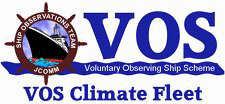» Introduction
 The VOS Climate (VOSClim) Fleet builds on the strong foundation of the VOS Climate Project that ran between 2001-2009.
The VOS Climate (VOSClim) Fleet builds on the strong foundation of the VOS Climate Project that ran between 2001-2009.
The VOSClim Project followed the successful VOS Special Observing Project North Atlantic (VSOP-NA) that was conducted on behalf of the World Climate Research Project (WCRP) between May 1988 - September 1990. The aim of VSOP-NA was to establish the effects on the quality of VOS data of different ship instrumentation and observing practices.
A review of the VOSClim Project was initiated in 2008 and concluded that the operational project goals had been achieved and that there were many positive results that should be applied across the entire VOS. It was proposed and agreed at SOT-V in 2009 to end the VOSClim Project and to create a new VOSClim class of VOS reporting vessel.
The aim of VOSClim is to provide a high-quality subset of VOS data in both real-time and in delayed-mode, supplemented by an extensive array of supporting information, known as metadata, to support global climate studies and research.
» View the VSOP-NA & VOSClim Project Documentation
VOSClim Requirements for Ship Officers & Observers
For observers and ships officers, the transition into the VOSClim fleet is virtually transparent. The program requires:
- Use of an electronic logbook such as SEAS (9.0 or later), or TurboWin to record and report meteorological observations.
- The following VOSClim parameters to be recorded and/or reported with each observation:
- Ship's course and speed over ground at time of observation,
- Ship's heading at time of observation,
- Maximum height of deck cargo above the summer maximum load line,
- Departure of summer maximum load line from actual sea level,
- Uncorrected (i.e. apparent) wind speed and direction.
- Assisting the Port Meteorological Officers (PMO) to gather all required metadata.
VOSClim Requirements for PMOs
The PMO shall also identify suitable ships for recruitment. The main objectives are to recruit VOSClim ships that:
- Can be routinely visited, ideally at less than six month intervals.
- Can be relied upon to provide regular, high quality observations.
- Are equipped with certified and calibrated instrumentation for measuring atmospheric pressure, air temperature, humidity and sea surface temperature. barometers should be able to meaure pressure to 0.1 hPa (preferably connected to a static head) while temperatures should be measured to 0.1o C.
- Are willing to use electronic logbook software, ideally installed on the ship's computer, which incluldes quality control checks, true wind computation and can also log the delayed-mode VOSClim data in IMMT-5 format.
Upon recruitment of a ship into the VOSClim fleet, the PMO shall collect an extensive list of metadata about the ship, including the location, type and exposure of the installed meteorological instruments as required for WMO No. 47.
The range of metadata is identical to that collected for a standard VOS, however it also includes mandatory digital photographs of the instruments and their location, and ship profile drawings showing the location of the instruments, noting any particular characteristics that might influence the meteorological readings, e.g. superstructure overhangs, ships ventilation exhausts that could affect the flow of air through a marine screen, or outflows on the hull that could affect sea temperature measurements.
Following recruitment the PMO will ensure the accuracy of the metadata at each visit, and provide guidance and instruction to observers. In addition, all delayed-mode data will be downloaded from the electronic logbooks and sent in to the National Meteorological Service (NMS) for processing. To recognise the efforts and contribution of observers, the PMO will also issue each project ship with a VOSClim Certificate of Participation.
Ships equipped with Automatic Weather Stations (AWS) can also be recruited to the VOSClim (AWS) class. The metadata shall be collected in the same way as for a manually reporting VOSClim class ship and the same range of measurements shall be collected by the calibrated sensors.. However the AWS shall have a facility to manually input the visually observed elements and to transmit data at least three hourly or more frequently.
Fleet Goals
The SOT has set goals to upgrade as many ships as possible into the VOSClim fleet, with close attention being paid to Quality, Quantity and Timeliness of the observations of the specialised VOSClim fleet.
- Quantity: upgrade at least 25% of the global active VOS fleet to VOSClim class.
- Quality: less than 3% of VOSClim class ships per month being flagged on the Suspect List for Air Pressure.
- Timeliness: 95% of VOSClim observations to be received within 120 minutes of the observation time.
Data Management and Access
VOSClim observations are collected from multiple sources, both in real time and in delayed-mode, and made available through the VOSClim Data Assembly Centre (DAC). Data are collected at NOAA's National Climatic Data Center (NCDC), converted to a common format, and made available through FTP and database access along with supporting quality monitoring statistics.
VOSClim observations are collected from 3 primary sources:
- GTS real time transmissions in FM13 SHIP code.
- UK Met Office BUFR transmissions with co-located NWP model output for higher level quality control (e.g. background air temp, sea level pressure, sst, winds, and relative humidity).
- Quarterly Global Collecting Center (GCC-UK & GCC-Germany) delayed-mode distributions with the required VOSClim parameters that not transmitted in real-time (e.g. ship's course and speed over ground, relative wind direction and speed, etc.).
